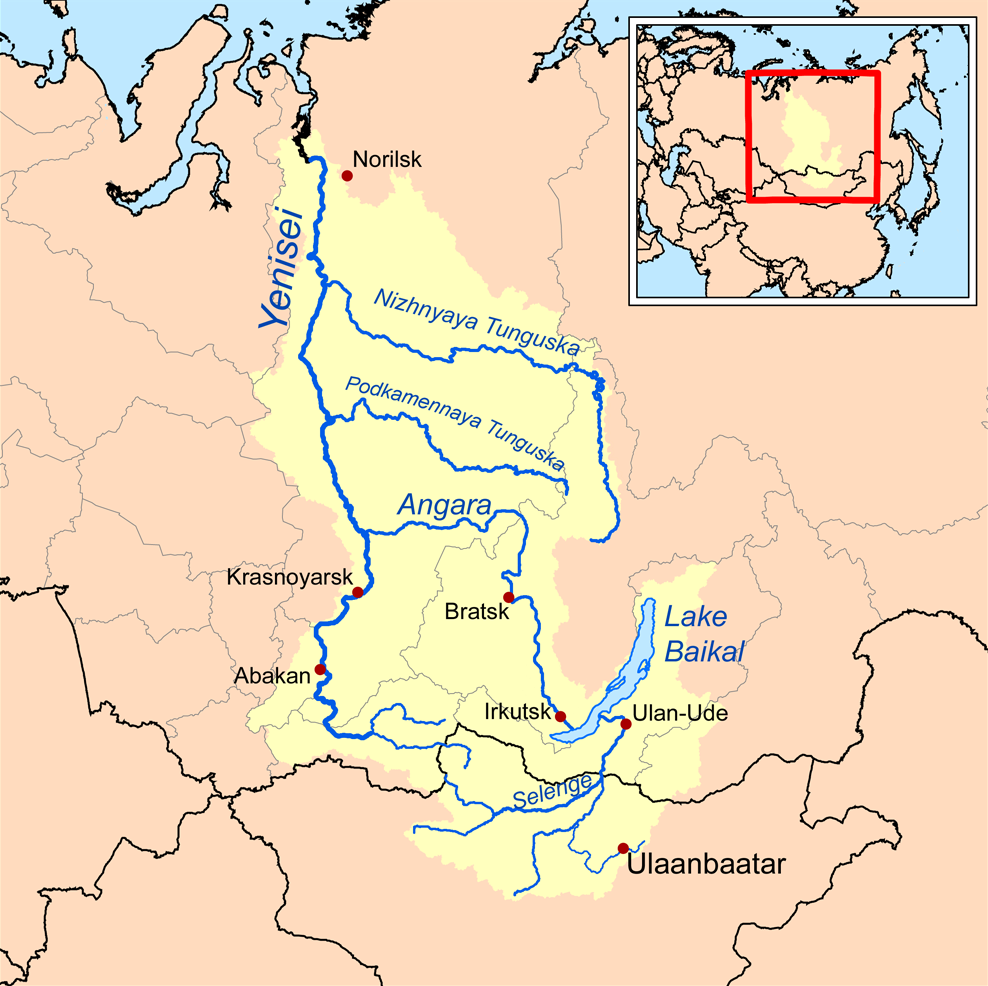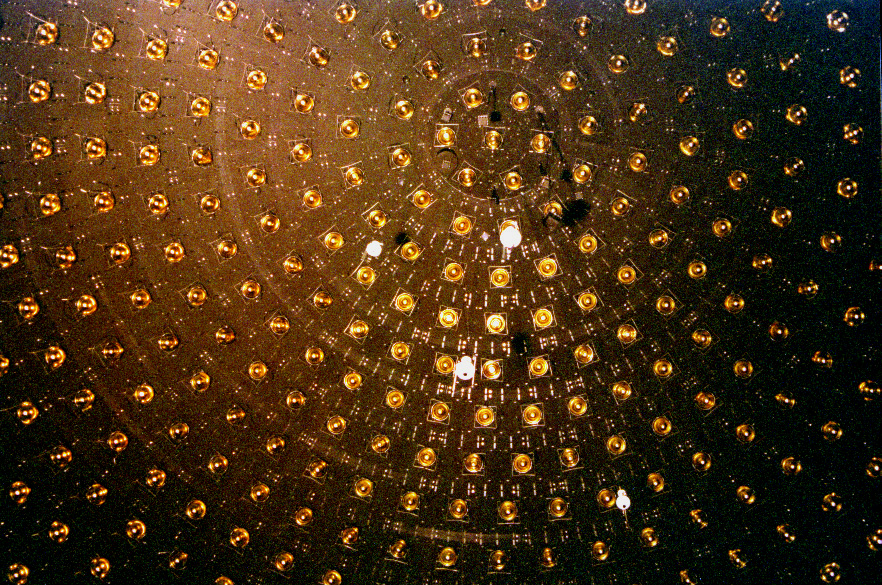|
Baikal Deep Underwater Neutrino Telescope
The Baikal Deep Underwater Neutrino Telescope (BDUNT) () is a neutrino detector conducting research below the surface of Lake Baikal (Russia) since 2003. The first detector was started in 1990 and completed in 1998. It was upgraded in 2005 and again starting in 2015 to build the Baikal Gigaton Volume Detector (Baikal-GVD.) BDUNT has studied neutrinos coming through the Earth with results on atmospheric muon flux. BDUNT picks up many atmospheric neutrinos created by cosmic rays interacting with the atmosphere – as opposed to cosmic neutrinos which give clues to cosmic events and are therefore of greater interest to physicists. Detector history The start of the Baikal neutrino experiment dates back to 1 October 1980, when a laboratory of high-energy neutrino astrophysics was established at the Institute for Nuclear Research of the former Academy of Sciences of the USSR in Moscow. This laboratory would become the core of the Baikal collaboration. The original NT-200 design was de ... [...More Info...] [...Related Items...] OR: [Wikipedia] [Google] [Baidu] |
Joint Institute For Nuclear Research
The Joint Institute for Nuclear Research (JINR, ), in Dubna, Moscow Oblast (110 km north of Moscow), Russia, is an international research center for nuclear sciences, with 5,500 staff members including 1,200 researchers holding over 1,000 Ph.D.s from eighteen countries. Most scientists are scientists of the Russian Federation. The institute has seven laboratories, each with its own specialisation: theoretical physics, high energy physics (particle physics), heavy ion physics, condensed matter physics, nuclear reactions, neutron physics, and information technology. The institute has a division to study radiation and radiobiological research and other ad hoc experimental physics experiments. Principal research instruments include a nuclotron superconductive particle accelerator (particle energy: 7 GeV), three isochronous cyclotrons (120, 145, 650 MeV), a phasitron (680 MeV) and a synchrophasotron (4 GeV). The site has a neutron fast-pulse reactor (1,500MW pulse) with ... [...More Info...] [...Related Items...] OR: [Wikipedia] [Google] [Baidu] |
Russian Academy Of Sciences
The Russian Academy of Sciences (RAS; ''Rossíyskaya akadémiya naúk'') consists of the national academy of Russia; a network of scientific research institutes from across the Russian Federation; and additional scientific and social units such as libraries, publishing units, and hospitals. Peter the Great established the academy (then the St. Petersburg Academy of Sciences) in 1724 with guidance from Gottfried Wilhelm Leibniz, Gottfried Leibniz. From its establishment, the academy benefitted from a slate of foreign scholars as professors; the academy then gained its first clear set of goals from the 1747 Charter. The academy functioned as a university and research center throughout the mid-18th century until the university was dissolved, leaving research as the main pillar of the institution. The rest of the 18th century continuing on through the 19th century consisted of many published academic works from Academy scholars and a few Academy name changes, ending as The Imperial ... [...More Info...] [...Related Items...] OR: [Wikipedia] [Google] [Baidu] |
Lake Baikal
Lake Baikal is a rift lake and the deepest lake in the world. It is situated in southern Siberia, Russia between the Federal subjects of Russia, federal subjects of Irkutsk Oblast, Irkutsk Oblasts of Russia, Oblast to the northwest and the Republic of Buryatia to the southeast. At —slightly larger than Belgium—Lake Baikal is the world's List of lakes by area, seventh-largest lake by surface area, as well as the second largest lake in Eurasia after the Caspian Sea. However, because it is also the List of lakes by depth, deepest lake, with a maximum depth of , Lake Baikal is the world's List of lakes by volume, largest freshwater lake by volume, containing of water or 22–23% of the world's fresh surface water, more than all of the North American Great Lakes combined. It is also the world's ancient lake, oldest lake at 25–30 million years, and among the clearest. It is estimated that the lake contains around 19% of the unfrozen fresh water on the planet. Lake Baikal ... [...More Info...] [...Related Items...] OR: [Wikipedia] [Google] [Baidu] |
Neutrino Detector
A neutrino detector is a physics apparatus which is designed to study neutrinos. Because neutrinos only weakly interact with other particles of matter, neutrino detectors must be very large to detect a significant number of neutrinos. Neutrino detectors are often built underground, to isolate the detector from cosmic rays and other background radiation. The field of neutrino astronomy is still very much in its infancy – the only confirmed extraterrestrial sources are the Sun and the supernova 1987A in the nearby Large Magellanic Cloud. Another likely source (three standard deviations) is the blazar TXS 0506+056 about 3.7 billion light years away. Neutrino observatories will "give astronomers fresh eyes with which to study the universe". Various detection methods have been used. Super Kamiokande is a large volume of water surrounded by phototubes that watch for the Cherenkov radiation emitted when an incoming neutrino creates an electron or muon in the water. The ... [...More Info...] [...Related Items...] OR: [Wikipedia] [Google] [Baidu] |
Russia
Russia, or the Russian Federation, is a country spanning Eastern Europe and North Asia. It is the list of countries and dependencies by area, largest country in the world, and extends across Time in Russia, eleven time zones, sharing Borders of Russia, land borders with fourteen countries. Russia is the List of European countries by population, most populous country in Europe and the List of countries and dependencies by population, ninth-most populous country in the world. It is a Urbanization by sovereign state, highly urbanised country, with sixteen of its urban areas having more than 1 million inhabitants. Moscow, the List of metropolitan areas in Europe, most populous metropolitan area in Europe, is the capital and List of cities and towns in Russia by population, largest city of Russia, while Saint Petersburg is its second-largest city and Society and culture in Saint Petersburg, cultural centre. Human settlement on the territory of modern Russia dates back to the ... [...More Info...] [...Related Items...] OR: [Wikipedia] [Google] [Baidu] |
BBC News
BBC News is an operational business division of the British Broadcasting Corporation (BBC) responsible for the gathering and broadcasting of news and current affairs in the UK and around the world. The department is the world's largest broadcast news organisation and generates about 120 hours of radio and television output each day, as well as online news coverage. The service has over 5,500 journalists working across its output including in 50 foreign news bureaus where more than 250 foreign correspondents are stationed. Deborah Turness has been the CEO of news and current affairs since September 2022. In 2019, it was reported in an Ofcom report that the BBC spent £136m on news during the period April 2018 to March 2019. BBC News' domestic, global and online news divisions are housed within the largest live newsroom in Europe, in Broadcasting House in central London. Parliamentary coverage is produced and broadcast from studios in London. Through BBC English Regions, th ... [...More Info...] [...Related Items...] OR: [Wikipedia] [Google] [Baidu] |
Institute For Nuclear Research
Institute for Nuclear Research of the Russian Academy of Sciences (INR RAS, ) is a Russian scientific research center "for further development of the experimental base and fundamental research activities in the field of atomic nucleus, elementary particle and cosmic ray physics and neutrino astrophysics". History It was founded in 1970 by the Decree of the USSR Council of Ministers. Located in Moscow, Russia near the Moscow State University and in Troitsk. The institute is a founder of the Baksan Neutrino Observatory, the Baikal Deep Underwater Neutrino Telescope (Lake Baikal) and the former Artemovskaya Scientific Station (Soledar, Ukraine). About 1,300 specialists including 5 academicians and 2 corresponding members of the RAS, 42 doctors and 160 candidates of science work in the institute. Directors * Albert Nikiforovich Tavkhelidze, academician of RAS (1970–1986) * Viktor Anatolyevich Matveev, academician of RAS, head of the Presidium of the Scientific Center of ... [...More Info...] [...Related Items...] OR: [Wikipedia] [Google] [Baidu] |
Muon
A muon ( ; from the Greek letter mu (μ) used to represent it) is an elementary particle similar to the electron, with an electric charge of −1 '' e'' and a spin of ''ħ'', but with a much greater mass. It is classified as a lepton. As with other leptons, the muon is not thought to be composed of any simpler particles. The muon is an unstable subatomic particle with a mean lifetime of , much longer than many other subatomic particles. As with the decay of the free neutron (with a lifetime around 15 minutes), muon decay is slow (by subatomic standards) because the decay is mediated only by the weak interaction (rather than the more powerful strong interaction or electromagnetic interaction), and because the mass difference between the muon and the set of its decay products is small, providing few kinetic degrees of freedom for decay. Muon decay almost always produces at least three particles, which must include an electron of the same charge as the muon and t ... [...More Info...] [...Related Items...] OR: [Wikipedia] [Google] [Baidu] |
Baksan Neutrino Observatory
The Baksan Neutrino Observatory (BNO; Baksan is sometimes spelled Baxan) is a scientific laboratory of INR RAS located in the Baksan River gorge in the Caucasus mountains in Russia. Cleared for building in 1967, it started operations in 1977, becoming the first such neutrino observatory in the USSR. It consists of the Baksan Underground Scintillation Telescope (BUST), located below the surface, the gallium–germanium neutrino telescope (Soviet–American Gallium Experiment, SAGE) located 4,700 m.w.e. deep (2,100 meters) as well as a number of ground facilities. The Baksan Experiment on Sterile Transitions (BEST) is currently (2019) being conducted at Baksan with aims of understanding sterile neutrinos. The laboratory itself is located in a 4,000 meter long horizontal tunnel mined specifically for this purpose; this is in contrast to most underground physics laboratories which are placed in abandoned or still in-use mines. The entrance of the tunnel is at a valley at 1,700 meter ... [...More Info...] [...Related Items...] OR: [Wikipedia] [Google] [Baidu] |
Neutrino Astronomy
Neutrino astronomy is a branch of astronomy that gathers information about astronomical objects by observing and studying neutrinos emitted by them with the help of neutrino detectors in special Earth observatories. It is an emerging field in astroparticle physics providing insights into the high-energy and non-thermal processes in the universe. Neutrinos are nearly massless and electrically neutral or chargeless elementary particles. They are created as a result of certain types of radioactive decay, nuclear reactions such as those that take place in the Sun or high energy astrophysical phenomena, in nuclear reactors, or when cosmic rays hit atoms in the atmosphere. Neutrinos rarely interact with matter (only via the weak nuclear force), travel at nearly the speed of light in straight lines, pass through large amounts of matter without any notable absorption or without being deflected by magnetic fields. Unlike photons, neutrinos rarely scatter along their trajectory. But like ... [...More Info...] [...Related Items...] OR: [Wikipedia] [Google] [Baidu] |
Science And Technology In Siberia
Science is a systematic discipline that builds and organises knowledge in the form of testable hypotheses and predictions about the universe. Modern science is typically divided into twoor threemajor branches: the natural sciences, which study the physical world, and the social sciences, which study individuals and societies. While referred to as the formal sciences, the study of logic, mathematics, and theoretical computer science are typically regarded as separate because they rely on deductive reasoning instead of the scientific method as their main methodology. Meanwhile, applied sciences are disciplines that use scientific knowledge for practical purposes, such as engineering and medicine. The history of science spans the majority of the historical record, with the earliest identifiable predecessors to modern science dating to the Bronze Age in Ancient Egypt, Egypt and Mesopotamia (). Their contributions to mathematics, astronomy, and medicine entered and shaped the Gree ... [...More Info...] [...Related Items...] OR: [Wikipedia] [Google] [Baidu] |





